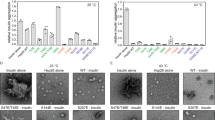Abstract
Members of the heat-shock protein family (hsp70s) can distinguish folded from unfolded proteins. This property is crucial to the role of hsp70s as molecular chaperones and is attributable to the amino-acid specificity of the peptide-binding site. The specificity for peptide ligands is investigated using a set of peptides of random sequence but defined chain length. The peptide-binding site selects for aliphatic residues and accommodates them in an environment energetically equivalent to the interior of a folded protein.
Similar content being viewed by others
References
Lippincott-Schwartz, J., Bonifacino, J. S., Yuan, L. C. & Klausner, R. D. Cell 54, 209–220 (1988).
Goldberg, A. L. & St John, A. C. A. Rev. Biochem. 45, 747–803 (1976).
Ostermann, J., Horwich, A. L., Neupert, W. & Hartl, F. U. Nature 341, 125–30 (1989).
Bole, D. B., Hendershot, L. M. & Kearney, J. F. J. Cell biol. 102, 1558–1566 (1986).
Rothman, J. E. Cell 59, 591–601 (1989).
Gething, M.-J., McCammon, K. & Sambrook, J. Cell 46, 939–950 (1986).
Chirico, W. J., Waters, M. G. & Blobel, G. Nature 332, 800–805 (1988).
Deshaies, R. J., Koch, B. D., Werner-Washburne, M., Craig, E. A. & Schekman, R. Nature 332, 800–804 (1988).
Kang, P.-J. et al. Nature 348, 137–143 (1990).
Beckmann, R. P., Mizzen, L. A. & Welch, W. J. Science 248, 850–853 (1990).
Palleros, D. R., Welch, W. J. & Fink, A. L. Proc. natn. Acad. Sci. U.S.A. 88, 5719–5723 (1991).
Flynn, G. C., Chappell, T. G. & Rothman, J. E. Science 245, 385–390 (1989).
Nozaki, Y. & Tanford, C. J. biol. Chem. 246, 2211–2217 (1971).
Matsumaura, M., Becktel, W. J. & Matthews, B. J. Nature 334, 406–410 (1988).
Miller, S., Janin, J., Lesk, A. M. & Chothia, C. J. molec. Biol. 196, 641–656 (1987).
Lim, W. A. & Sauer, R. T. Nature 339, 31–36 (1989).
Elsenberg, D., Weiss, R. M. & Terwilliger, T. C. Proc. natn. Acad. Sci. U.S.A. 81, 140–144 (1984).
Kapper, M. H. Biochem. biophys. Res. Commun. 78, 1018–1024 (1977).
Lewis, M. J. & Pelham, H. R. B. EMBO J. 4, 3137–3143 (1985).
Pelham, H. R. B. Cell 46, 959–961 (1986).
Chappell, T. G., Konforti, B. B., Schmid, S. L. & Rothman, J. E. J. biol. Chem. 262, 746–751 (1987).
Flajnik, M. F., Canel, C. C., Kramer, J. & Kasahara, M. Proc. natn. Acad. Sci. U.S.A. 88, 537–541 (1991).
Flajnik, M. F., Canel, C., Kramer, J. & Kasahara, M. Immunogenetics (in the press).
Rotzschke, O. et al. Nature 348, 252–254 (1990).
Schumacher, T. N. M. et al. Nature 350, 703–706 (1991).
Falk, K., Rotzschke, O., Stevanovic, S., Jung, G. & Rammensee, H.-G. Nature 351, 290–296 (1991).
Devlin, J. J., Panganiban, L. C. & Devlin, P. E. Science 249, 404–406 (1990).
Scott, J. K. & Smith, G. P. Science 249, 386–390 (1990).
Fodor, S. P. A. et al. Science 251, 767–773 (1991).
Chang, C. D. & Meienhofer, J. Int. J. Pept. Protein Res. 11, 246–249 (1975).
Cresfield, A. M., Stein, W. H. & Moore, S. J. biol. Chem. 238, 618–621 (1963).
Tack, B. F., Dean, J., Eilat, D., Lorenz, P. & Schechter, A. N. J. biol. Chem 255, 8842–8847 (1980).
Hewick, R. M., Hunkapiller, M. W., Hood, L. E. & Dreyer, W. J. biol. Chem. 256, 7990–7997 (1981).
Pohl, J., Pereira, H. A., Martin, N. M. & Spitznagel, J. K. FEBS Lett. 272, 200–204 (1990).
Tanford, C. J. Am. Chem. Soc. 84, 4240–4247 (1962).
Author information
Authors and Affiliations
Rights and permissions
About this article
Cite this article
Flynn, G., Pohl, J., Flocco, M. et al. Peptide-binding specificity of the molecular chaperone BiP. Nature 353, 726–730 (1991). https://doi.org/10.1038/353726a0
Received:
Accepted:
Issue Date:
DOI: https://doi.org/10.1038/353726a0
- Springer Nature Limited
This article is cited by
-
ER Ca2+ overload activates the IRE1α signaling and promotes cell survival
Cell & Bioscience (2023)
-
Caffeine blocks SREBP2-induced hepatic PCSK9 expression to enhance LDLR-mediated cholesterol clearance
Nature Communications (2022)
-
Autism-associated mutation in Hevin/Sparcl1 induces endoplasmic reticulum stress through structural instability
Scientific Reports (2022)
-
Mapping SP-C co-chaperone binding sites reveals molecular consequences of disease-causing mutations on protein maturation
Nature Communications (2022)
-
Secretome analysis of an environmental isolate Enterobacter sp. S-33 identifies proteins related to pathogenicity
Archives of Microbiology (2022)





